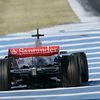MP4-23 factfile and specs

Vodafone McLaren Mercedes today presented the MP4-23, the team’s 2008 Formula 1 car, at the Mercedes-Benz Museum in Stuttgart. Here follows the factfile of the new 2008 contender and the technical specifications.
The first design meeting for the MP4-23 took place back in November 2006 with early layout work starting in March 2007.
Wind tunnel work commenced in late May 2007.
Since then the MP4-23 has spent over 3000 hours being developed in the wind tunnel.
The first MP4-23 chassis was ready for bonding in mid November 2007.
Lewis Hamilton, Pedro de la Rosa and Gary Paffett had their provisional seat fittings for the MP4-23 back in September 2007. Heikki Kovalainen was fitted for his seat shortly after being announced as a Vodafone McLaren Mercedes driver.
The car build process for chassis 1 began in early December 2007 and was finished in early January 2008.
Throughout the development process 150 different engineers have been involved in the whole project in all disciplines.
14000 engineering man hours have so far been put into the MP4-23 development project.
A similar number applies to the manufacturing man hours involved to produce the MP4-23 in time for its track debut on the 9th January 2008.
The MP4-23 is an evolution of the MP4-22 and as such there is no significant visual difference currently, however between now and the first race in Australia there are planned upgrades on most of the aerodynamic surfaces, wings, bodywork, bargeboards and additional bodywork components.
Alongside the development of the 2008 challenger, concept work has been started for the 2009 car since November 2007, with the KERS project (energy storage) beginning a year ago.
MP4-23 TECHNICAL SPECIFICATION
Engine
Type: Mercedes-Benz FO 108V
Capacity: 2.4 litre
No. of cylinders: 8
Max. rpm: 19,000 (FIA regulatory limit since 2007)
Bank angle: 90O
Piston bore maximum: 98 mm (FIA regulation)
Bore spacing: 106.5 mm
Number of valves: 32
Fuel: Mobil 1 Unleaded (5.75% bio fuel)
Lubricants: Mobil 1, newly developed 2008 formula for lower friction and better wear resistance
Engine: 95kg (minimum FIA regulation weight)
Transmission
Gearbox Speeds: Seven forward and one reverse
Semi-auto: Yes
Driveshafts: McLaren
Clutch: Hand-operated
Chassis
Chassis: McLaren moulded carbon fibre/aluminium honeycomb composite incorporating front and side impact structures. Contains integral safety fuel cell
Front Suspension: Inboard torsion bar/damper system operated by pushrod and bell crank with a double wishbone arrangement
Rear Suspension: Inboard torsion bar/damper system operated by pushrod and bell crank with a double wishbone arrangement
Suspension Dampers: Koni
Electronics: McLaren Electronic Systems control units incorporating electronics for chassis, engine and data acquisition. McLaren Electronic Systems also supplies the electronic dash board, alternator voltage control, sensors, data analysis and telemetry systems
Bodywork Construction: One-piece engine cover; separate sidepod covers; separate floor section, structural nose with integral front wing.
Tyres: Bridgestone Potenza
Radios: Kenwood
Race Wheels: Enkei
Batteries: GS Yuasa Corporation
Steering: McLaren power-assisted
Instruments: McLaren Electronic Systems







